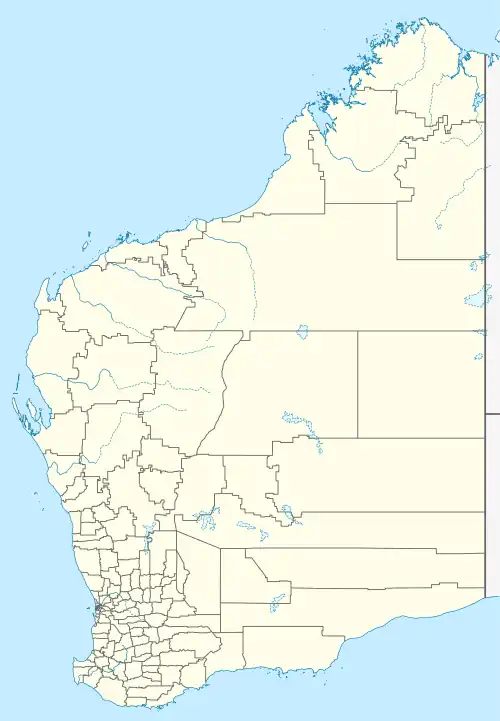| Dalwallinu Western Australia | |||||||||
|---|---|---|---|---|---|---|---|---|---|
.jpg.webp) Johnston Street, Dalwallinu, 2018 | |||||||||
 Dalwallinu | |||||||||
| Coordinates | 30°16′35″S 116°39′45″E / 30.2765°S 116.6625°E | ||||||||
| Population | 713 (UCL 2021)[1] | ||||||||
| Established | 1910 | ||||||||
| Postcode(s) | 6609 | ||||||||
| Elevation | 335 m (1,099 ft) | ||||||||
| Area | 684.2 km2 (264.2 sq mi) | ||||||||
| Location | 248 km (154 mi) NNE of Perth | ||||||||
| LGA(s) | Shire of Dalwallinu | ||||||||
| State electorate(s) | Moore | ||||||||
| Federal division(s) | Durack | ||||||||
| |||||||||
Dalwallinu (/ˈdaʊlwɒlɪnju/ or /dælˈwɒlənju/), colloquially called Dally, is a town in the Wheatbelt region of Western Australia, located 248 km from Perth via the Great Northern Highway. Agriculture and supporting industries are the town's primary economic activities. The town is the first town on the Wildflower Way, a tourist route that stretches north to Mullewa. The town has an elevation of 335 metres (1,099 ft).[2] At the 2016 census, Dalwallinu had a population of 699.[3]
The name of the town comes from a now unknown Aboriginal word that means "place to wait a while" or possibly "good lands". Traditionally, the Badimaya people lived in the northern areas of the shire and the Karlamaya people inhabited the southern areas.[4]
Originally called South Nugadong, the town was officially gazetted in 1914.[5][6]
The first Europeans to arrive were Benedictine monks who came from New Norcia to graze their sheep on the pastoral leases that they had taken up. The first settlers arrived, hoping to develop the lands for wheat, in 1907. The region was surveyed in 1909 and then opened for selection in 1910 with crops being planted shortly afterward.[6][7]
Two brothers, Albert and Frederick Ellison, built a well on the southern end of the township in 1909. The well acted as a permanent source of water to the settlers. The well, named Billum Billum well, was built from locally occurring timber such as gimlet and salmon gum.[8]
In 1932 the Wheat Pool of Western Australia announced that the town would have two grain elevators, each fitted with an engine, installed at the railway siding.[9] Dalwallinu is on the railway route that used to be utilised for Northam to Mullewa rail services, such as The Mullewa. They no longer operate, with the line inoperational between Dalwallinu and Perenjori South.[10]
References
- ↑ Australian Bureau of Statistics (28 June 2022). "Dalwallinu (urban centre and locality)". Australian Census 2021.
- ↑ "Bureau of Meteorology – Dalwallinu Comparison". 2008. Retrieved 26 August 2008.
- ↑ Australian Bureau of Statistics (27 June 2017). "Dalwallinu (L) (Urban Centre/Locality)". 2016 Census QuickStats. Retrieved 6 April 2019.
- ↑ Bednall, James (2014). Badimaya Dictionary. Geraldton, WA: Bundiyarra Irra Wangga Language Centre. pp. 7–9. ISBN 9780987156686.
- ↑ "New Townsite "Dalwallinu"" (PDF). Government Gazette of Western Australia. Government of Western Australia: 1364. 6 March 1914. Retrieved 20 April 2019.
- 1 2 "Land open for selection" (PDF). Government Gazette of Western Australia. Perth, WA: Government of Western Australia (5): 155. 28 January 2010. Retrieved 20 April 2019.
- ↑ "Welcome to Western Australia – Dalwallinu". 2005. Archived from the original on 26 July 2008. Retrieved 26 August 2008.
- ↑ "Billum-Billum Monks Well". 2002. Retrieved 26 August 2008.
- ↑ "Country elevators". The West Australian. Perth. 6 July 1932. p. 10. Retrieved 6 April 2013 – via National Library of Australia.
- ↑ https://www.arcinfra.com/ARCInfrastructure/media/documents/Network%20Specifications/Arc-Infrastructure-Network-Control-Boundaries.pdf
External links
![]() Media related to Dalwallinu, Western Australia at Wikimedia Commons
Media related to Dalwallinu, Western Australia at Wikimedia Commons